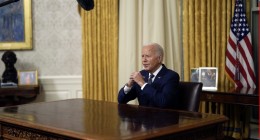Cruise, the driverless car subsidiary of General Motors, said in a report on Thursday that an adversarial approach taken by its top executives toward regulators had led to a cascade of events that ended with a nationwide suspension of Cruise’s fleet.
The roughly 100-page report was compiled by a law firm that Cruise hired to investigate whether its executives had misled California regulators about an October crash in San Francisco in which a Cruise vehicle dragged a woman 20 feet. The investigation found that while the executives had not intentionally misled state officials, they had failed to explain key details about the incident.
In meetings with regulators, the executives let a video of the crash “speak for itself” rather than fully explain how one of its vehicles severely injured the pedestrian. The executives later fixated on protecting Cruise’s reputation rather than giving a full account of the accident to the public and media, according to the report, which was written by the Quinn Emanuel Urquhart & Sullivan law firm.
The company said that the Justice Department and the Securities and Exchange Commission were investigating the incident, as well as state agencies and the National Highway Traffic Safety Administration.
The report is central to Cruise’s efforts to regain the public’s trust and eventually restart its business. Cruise has been largely shut down since October, when the California Department of Motor Vehicles suspended its license to operate because its vehicles were unsafe. It responded by pulling its driverless cars off the road across the country, laying off a quarter of its staff and replacing Kyle Vogt, its co-founder and chief executive, who resigned in November, with new leaders.
Cruise didn’t name Mr. Vogt in a blog post summarizing the law firm’s review. Mr. Vogt declined to comment.
The summary of the report was a long list of reasons to explain why regulators accused Cruise of misleading them. The law firm found that an engineer who had provided video of the crash to regulators had a poor internet connection that prevented the regulators from seeing a complete and clear version of the video. Some senior Cruise leaders also didn’t know the details of the incident before a meeting with state officials.
Last month, Cruise dismissed nine people, including most of those who met with the D.M.V. Its vice president of communications later departed. It eliminated about 900 of 3,800 positions, mostly corporate and commercial roles that were less important after it suspended its operations.
Cruise hopes that the investigation will help to repair its reputation and clear a path for it to restart its self-driving business. It believes that its problem was the outgrowth of a leadership team that made quickly building out a business a priority over the safety of its operations.
Cruise is providing the report to the D.M.V. and the California Public Utilities Commission, which authorizes driverless car programs in the state. It said it would make it available to the public as well.
The report will be closely scrutinized by everyone with an interest in the future of driverless cars. Cruise’s troubles have stoked concern among the tech and auto companies that have poured billions into developing the technology. It also amplified the safety concerns of regulators and people who have been worried about the risks created when robots take to the road.
In Cruise’s absence, Waymo, which was started by Google, has become the only self-driving car operation offering taxi rides in San Francisco. Though Waymo’s fleet of roughly 250 cars has had few major incidents, the City of San Francisco sued the State of California last month for allowing Waymo and Cruise vehicles to operate without tighter regulations.
“We know our license to operate must be earned and is ultimately granted by regulators and the communities we serve,” Cruise said in its blog post. “We are focused on advancing our technology and earning back public trust.”
Cruise is the latest tech company to tap a law firm to review its business. Uber hired former Attorney General Eric H. Holder to examine issues of sexual harassment and wrongdoing under co-founder Travis Kalanick.
How Cruise responded to the Oct. 2 crash inflamed regulators’ concerns over the crash itself. Another car hit the woman in a San Francisco intersection and flung her into the path of one of Cruise’s vehicles. The Cruise car stopped and then drove forward 20 feet, dragging the woman as it pulled to the curb.
The report said that although the Cruise leadership team and personnel did not try to deceive or mislead regulators during key meetings with a variety of government officials the day after the incident, they did not explain that a technical problem that had caused the car to drag the pedestrian after she was struck.
Rather than share with the D.M.V. a full video taken by the Cruise vehicle of the crash, state officials said, Cruise shared an abbreviated version that ended with its car stopping. It omitted footage of the car dragging the woman. The D.M.V. said it had learned of the full video from another agency.
The report commissioned by Cruise said that the company had shared the video with some regulators, but that when an employee showed the video during the Oct. 3 meetings, “transmission issues” impeded or prevented regulators from seeing that the car had dragged the pedestrian.
“They could have survived this if they had been honest, but they took a different approach and wound up destroying their reputation,” said Matthew Wansley, a professor at the Cardozo School of Law in New York who specializes in emerging automotive technologies. “To recover, they had to have a fully transparent autopsy of what happened.”
G.M., which bought Cruise in 2016 for $1 billion, has stepped in to steer the company. It installed its general counsel, Craig Glidden, as president of Cruise and made him responsible for overseeing the investigation and helping to evaluate how the business should proceed. Mr. Glidden is trying to change the culture of the company to put more emphasis on safety and transparency with regulators and the public.
Among the changes that the company plans to make is overhauling how it calculates the safety of its vehicles, a person with knowledge of the report said. Previously, Cruise was focused on accumulating as many miles as possible without incident so it could demonstrate that its driverless cars are safer than those driven by people. The company is in the process of defining a new approach.
Even before the Oct. 2 accident, Cruise’s cars were generating headlines for other issues, including a collision with a fire truck and an incident in which one of its cars drove into wet concrete and got stuck.







